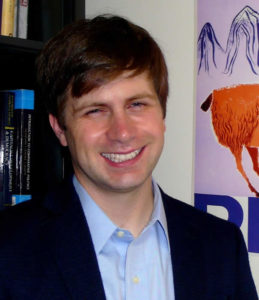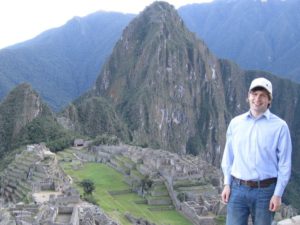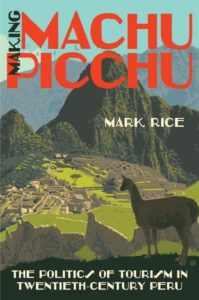 The SSRC sat down with Mark Rice, a 2009 alumnus of the Dissertation Proposal Development (DPD) Program and assistant professor of Latin American history at Baruch College (CUNY), to discuss his recent book, Making Machu Picchu: The Politics of Tourism in Twentieth-Century Peru (University of North Carolina Press, 2018). We discussed the importance of tourism as a lens of analysis, the role of tourism in shaping nationalism, and what to do when your fieldwork goes awry. To learn more about his work, check out his web page or follow him on Twitter, @MarkRiceHistory.
The SSRC sat down with Mark Rice, a 2009 alumnus of the Dissertation Proposal Development (DPD) Program and assistant professor of Latin American history at Baruch College (CUNY), to discuss his recent book, Making Machu Picchu: The Politics of Tourism in Twentieth-Century Peru (University of North Carolina Press, 2018). We discussed the importance of tourism as a lens of analysis, the role of tourism in shaping nationalism, and what to do when your fieldwork goes awry. To learn more about his work, check out his web page or follow him on Twitter, @MarkRiceHistory.
How did Machu Picchu develop into the famous destination it is today?
Machu Picchu had a circuitous route to becoming famous. If you look at research on Machu Picchu, there is a lot about the Inca, and about how it was “discovered” in 1911 by Hiram Bingham, a US explorer. After the “discovery” there was this assumption that it was just destined to become famous. Tourism is part of that. Tourism, by design, hides the mundane, the banal, the questions of labor and economics. When you’re on vacation, the last thing you want to think about is, “Who built this road?” Tourism likes to hide the mechanisms of politics and labor that make it successful.
By simply questioning the assumption that Machu Picchu was “discovered” and therefore becomes famous, I found out that, in reality, this wasn’t supposed to be Machu Picchu’s destiny. Instead, there was this fascinating story of local politics and transnational networks that made it famous. There were a lot of “near-death experiences” for Machu Picchu and no guarantee it was going to become a tourist destination and symbol of Peru. But, one constant is that there was regional interest in making Machu Picchu famous. The region of Cusco’s elite and intellectuals became invested in using tourism to elevate the region as an iconic Peruvian place. Another constant was transnationalism. Cuzqueños, the people from Cusco, proved very adept at reaching out using tourism, cultural ties, and diplomatic links beyond the Peruvian state to create tourism. The Peruvian state was often an unreliable partner in developing tourism. By cultivating these transnational networks through travel companies, investment banks, Good Neighbor–era diplomats, and universities, Cuzqueños relied on networks that were independent of the national state, which sometimes lacked interest in creating a tourism policy.
Why is it important to study tourism?
If you look at the UN’s World Tourism Organization statistics, tourism is 10 percent of the world’s GDP.1World Tourism Barometer 17, no. 2 (May 2019). It is one of the largest economic activities in the world. Although it’s easy to dismiss it as “people going on vacation,” for entire countries, tourism is their economy, so it’s critical to understand how it develops, who are the stakeholders, and what are the political, economic, and cultural consequences. Additionally, tourism is how a lot of people learn about the world, right? I always joke, someone who goes to Peru is going to learn history. I hope they learn it from reading my book—but their big introduction to Peruvian history is narratives they read in guidebooks and hear from tour guides. We have to understand how these narratives are constructed, who constructed them, and what are problems in these narratives. Because, like it or not, tourism provides the lens through which many people understand other cultures.
You were a 2009 DPD fellow in the State Violence field. Can you tell me about your experience with the program?
I won the fellowship with a project to look at state violence in Chile, at a time when Chile was rapidly expanding its frontiers. Without DPD I would’ve never had the opportunity to travel to Chile for a summer to see if this was a feasible project. Many Latin American archives are not digitized. You still need to go to these places to see what’s there.
What happened when you got to the field that summer?
Don’t tell the SSRC this but I took their money and decided I didn’t want to do this project. [laughter] I joke that I was a successful failure. What I mean is that I went to Chile and I found archives I could use. But I increasingly grew disenchanted with the project. It would’ve involved a type of research that I found very tedious. A dissertation under the best of circumstances is often really difficult. Every day may not be fun. But you need to at least be in that archive having confidence that you’re invested in the project. In some ways the preliminary research was this failure, since I ended up shifting dramatically away from themes of state violence and Chile. But at the same time, it was an important experience in showing me this project wasn’t going to be rewarding to me.
How did you move forward when you realized this wasn’t the topic that you wanted to study?

It was tough because there’s this fear of “Now I really have to pick a dissertation topic, but what if the same experience happens?” I was fortunate to have advisors who said there’s no shame in trying something and not finding it compelling. In desperation, I went to Peru searching for dissertation topics. I kept bumping into tourists. One day I realized, “Well, I’m in Peru because I’m looking for a dissertation topic, but why are all these other people coming here?” No one had approached tourism as economic development in Peru and thought that, like mining or agriculture, tourism needs infrastructure, political decisions, and involves political tensions. That’s when the lightbulb went off and I started to say, “Let’s look at how a place like Machu Picchu actually becomes famous.”
The experience from the DPD Program of looking at a project, theme, or problem through different disciplinary lenses allowed me to shift my project much more easily. In the DPD group discussions, it was fascinating to look at how sociologists, political scientists, geographers, and anthropologists were approaching problems. These insights ended up being very helpful when I switched topics. It encouraged me to look at how other disciplines were analyzing tourism, because historians were some of the last to study tourism critically. The experiences gained from the DPD made me much more comfortable seeking out other disciplines and reading the sociology of tourism.
How has tourism shaped Peruvian national identity?
Peru has often been held up by scholars of nationalism as a country that has an incomplete or failed national identity. Peruvians often asked: What was it going to be? What did Peruvianness look like? Some people wanted to emulate Europe. There were other national elites based in Lima for whom the Andean Indigenous cultures had to be left behind. Others argued for a mestizo national identity, a kind of national mixing. In places like Cusco there was pride in indigenous heritage.
Often scholars of nationalism explain its success or failure in terms of domestic politics. If a country had strong economic development or political parties and institutions, this produces strong nationalism. Peru’s weak economic development and political structures explained its lack of nationalism. But in cases where you have weak domestic structures, transnational links like tourism can offer shortcuts. Peruvian leaders in the twentieth century could not decide what was representative of Peru. But increasingly, tourists seemed to think that Machu Picchu was really interesting. In some ways, it’s tourism that ironically—by being transnational—elevates Machu Picchu as this symbol of Peru. If you think about it, Peru is rather unique now. Peru went from the start of the twentieth century having a lack of consensus on its national identity, to now having one of the most iconic immediate symbols of national identity: Machu Picchu. So, how do we do explain this reversal and rise of a national symbol? I argue that it’s tourism that was quite instrumental in selecting and then elevating Machu Picchu.
What are potential drawbacks or shortcomings of having a national identity that relies heavily on tourism when creating a national narrative?
If tourism can be the shortcut to creating national identity, it’s also worth noting that it is an identity that is iconic, but also unmoored. Machu Picchu is a powerful symbol, but it’s also unique in that it’s more famous for being forgotten than remembered. Tourism, because it’s created for consumers, is going to produce narratives that are pleasant. If tourism can create and elevate powerful symbols of national identity, there’s also a risk that the symbols can be unmoored from the actual political and social realities. Machu Picchu is ubiquitous, but it’s also a bit empty. If you look at a picture of Machu Picchu, the one thing that’s always missing is people. It celebrates this utopian vision of an Incan past, but is skirting the question of “what are the contemporary problems of Indigenous politics?” Peruvian history after independence is complicated. In the 1980s, Peru experienced a violent internal war where 60,000 people were killed. Machu Picchu lets tourists and Peruvians talk about Peruvian history, but one that’s not messy—“The Incas did this, and then it’s forgotten.” Part of the appeal of Machu Picchu is that it’s perceived as untouched. But history isn’t pristine. It’s messy, it involves problems.
What role did transnationalism play in your research?
One thing I found was how transnationalism can tell us a lot about relations between the region and the nation. We often think of transnational connections as between the region and the world or the nation and the world. In the case of Peru, it was also very effective at showing tensions between Cusco and the national state based in Lima. Arguably, one reason why Cuzqueños tried to embrace tourism was because of hostility toward their regional identity from national elites. How these transnational actors were acting between Cusco and Lima revealed a lot about the tension between Peru’s coastal region, where most of the political power was, and its Andean regions, which held a lot of economic activity, potential for revolution, and history.
What do you find to be the most exciting part of your work?
Well, besides ruining people’s vacations when I have to tell them that…No, I’m not that mean. I try to not be that guy who, when someone says to me: “I had a wonderful time at Machu Picchu,” responds: “You know it’s kind of an invented narrative.” But one benefit of researching Machu Picchu is that it’s romanticized. Rather than destroy that romanticism, in some ways it’s a perfect way to talk about history with people. For example, when encountering a tourist who thinks Machu Picchu is this mystical place, it’s a wonderful gateway to say, “Yes, it is mystical, but I bet you didn’t know how they made it that way.” It opens up this whole new narrative of twentieth-century Peru, which most tourists don’t think about. They go to Peru to think about the Inca and colonial history. Complicating the narrative around Machu Picchu isn’t a way of ruining vacations, it’s actually a way of thinking about Peru and history more broadly.
What is the most challenging aspect of your work?
 Researching tourism is tough. For many years, because tourism was thought to be vacation and leisure, many academics never considered it worthy of scholarly analysis. I joke I always imagine someone working in the Peruvian Tourism Promotion Office in the 1960s making a brochure, putting it in a file cabinet, looking at it five years later and saying, “No one is going to look at this, it’s already out of date” and throwing it away. Very few people took tourism seriously as a site of academic criticism. It has an archival past that reflects that lack of seriousness. As a result, I was forced to look at newspapers, US archives, and personal papers, which made it difficult to research because I was running between Peruvian and US archives. The silver lining, however, was it forced me to come up with a holistic picture of the story of Machu Picchu. If I had the ease of just going to the tourism archive, I probably wouldn’t have been forced to look at nonstate actors, academics, random tourism entrepreneurs, and radio hosts who were actually quite critical in spreading public knowledge of Machu Picchu.
Researching tourism is tough. For many years, because tourism was thought to be vacation and leisure, many academics never considered it worthy of scholarly analysis. I joke I always imagine someone working in the Peruvian Tourism Promotion Office in the 1960s making a brochure, putting it in a file cabinet, looking at it five years later and saying, “No one is going to look at this, it’s already out of date” and throwing it away. Very few people took tourism seriously as a site of academic criticism. It has an archival past that reflects that lack of seriousness. As a result, I was forced to look at newspapers, US archives, and personal papers, which made it difficult to research because I was running between Peruvian and US archives. The silver lining, however, was it forced me to come up with a holistic picture of the story of Machu Picchu. If I had the ease of just going to the tourism archive, I probably wouldn’t have been forced to look at nonstate actors, academics, random tourism entrepreneurs, and radio hosts who were actually quite critical in spreading public knowledge of Machu Picchu.
What advice would you give to graduate students pursuing fieldwork?
Be dogged in pursuing your sources. My favorite anecdote is about going to the Ministry of Tourism and External Commerce. I would go every week and ask, “Do you have an archive?” They’d say, “If you go online, we have spreadsheets of the past five years of arrivals.” And I’d say, “No, the historical archive.” I’d keep going and finally one day they sent me to this guy who had been there for 30 years, and he sits back in his desk and goes, “Well, we have the central archive.” He got on the phone and tells me, “Here’s the address, report there on Monday.” So, I went to this archive in an abandoned school in a suburb in Lima. There were two guys there at a card table. I asked, “Has anyone done research here?” They said no. It was a gymnasium filled with these really valuable archives.
Also, be prepared for surprises. I started this project as an economic history. I was shocked when I found out that for most of Machu Picchu’s history it was not economically important. Even within Cusco, the amount of tourism was rarely the most important economic activity. I was looking at the 1950s and 1960s and the tourism arrivals were incredibly low, which at first seems pretty bad if you’re trying to talk about tourism being influential. But rather than look at that as a failure, I thought “How do we explain this disconnect?” So, the project shifted to “Why did Cuzqueños embrace tourism?”
What’s next?
My next project is about road construction in Peru. If you were to pick up an old Peruvian magazine and go to the travel section, you’d find articles and advertisements saying, “Get in your car and drive up the coast!” Peru had this real embrace of automobile travel. What I’ve been discovering is that from 1920 to 1950, Peru had one of the largest road construction campaigns in Latin America. It built thousands of kilometers of highways, which was critical because Peru had missed out on the railway boom. Building highways was going to open up the Andean interior to global capitalism. I also want to look at the ways in which Peruvians adopted it culturally. What I’m seeing is that road construction wasn’t just a question of infrastructure, it was a question of national pride. It was a way for Peruvians to show their modernity, to show that they’re capable of accomplishing infrastructure. The other interesting aspect is the Peruvian government passed what was called the Conscription Law, which essentially set up a draft of mainly Indigenous citizens to work on these highways. There’s this tremendous contradiction in which Peru, particularly the middle class and elites in cities, are looking to highways as the path to modernization. But they’re reusing the most colonial of labor systems to build these highways.
The conversation has been edited for clarity and length.













